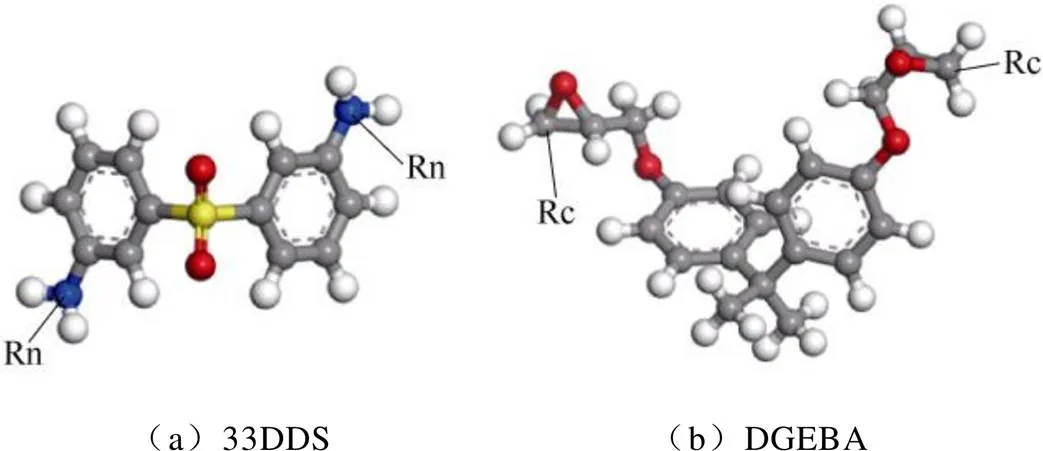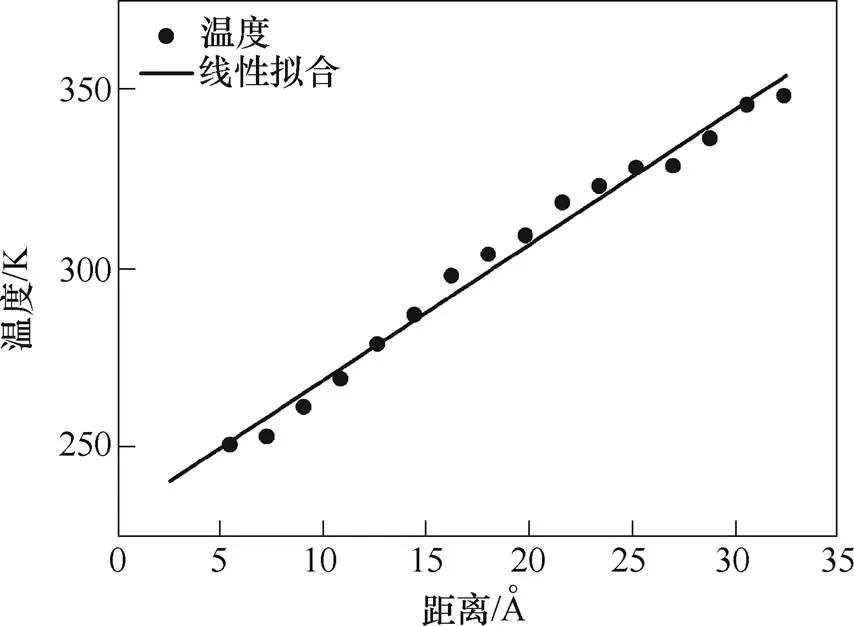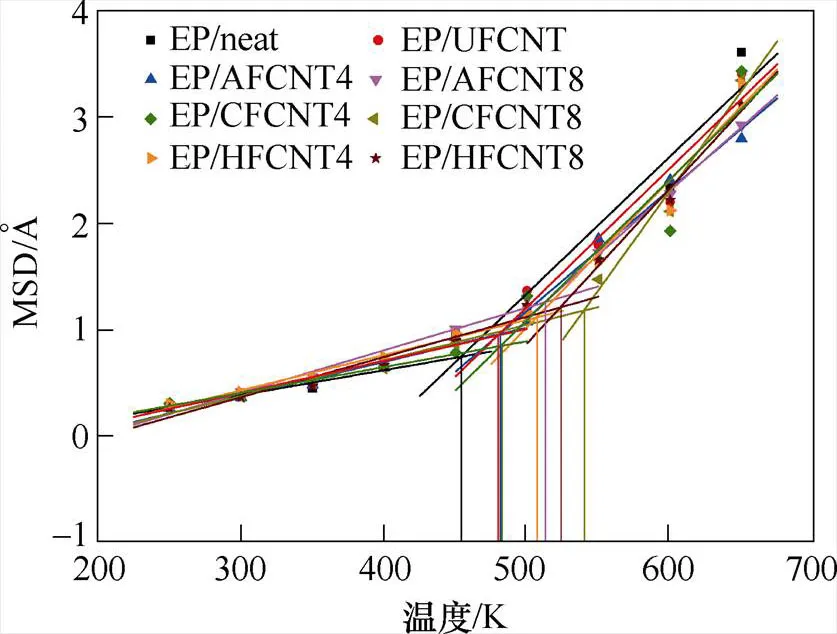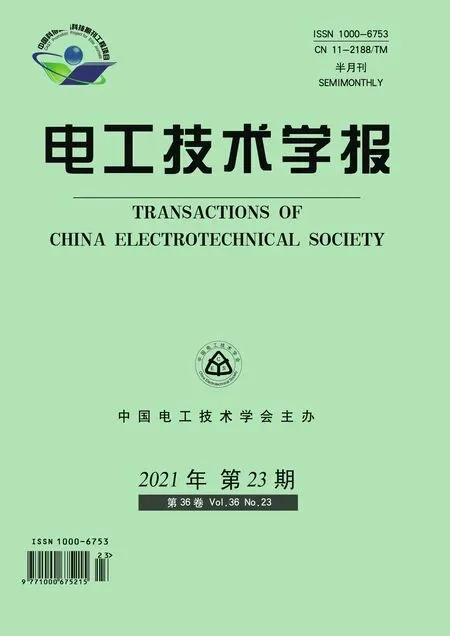功能化掺杂对交联环氧树脂/碳纳米管复合材料热力学性能影响的分子动力学模拟
2021-12-22李庆民
丁 咪 邹 亮 张 黎 赵 彤 李庆民
功能化掺杂对交联环氧树脂/碳纳米管复合材料热力学性能影响的分子动力学模拟
丁 咪1邹 亮1张 黎1赵 彤1李庆民2
(1. 山东大学电气工程学院 济南 250061 2. 新能源电力系统国家重点实验室(华北电力大学) 北京 102206)
为探究不同功能化碳纳米管掺杂对环氧树脂/碳纳米管复合材料热力学性能的影响,基于分子动力学模拟方法,建立掺杂功能化碳纳米管(CNT)的环氧树脂(EP)基纳米复合材料:纯环氧树脂模型及分别掺杂未功能化、氨基功能化、羧基功能化和羟基功能化的七种EP/CNT模型(其中,功能化CNT分别接枝4或8个官能团)。基于上述模型,在LAMMPS下计算热扩散系数(热导率和比热容)、玻璃转化温度及力学性能。结果表明,掺杂碳纳米管的环氧树脂纳米复合材料的各性能都有不同程度的提升,掺杂接枝8个官能团碳纳米管的EP/CNT性能提升均明显高于掺杂接枝4个相对应官能团EP/CNT的性能。其中,EP/AFCNT8在热导率、热扩散系数及力学性能上提升最明显,整体热导率和热扩散系数分别提升了54.92%和67.30%;EP/HFCNT8具有最大玻璃转化温度,提升幅度为69.47K,EP/AFCNT8提升幅度仅次于EP/HFCNT8,为58.97K。在400K时,EP/CFCNT8具有体积模量和杨氏模量最明显的提升,分别为52.4%、35.5%;因为氨基与环氧基体的交联反应,EP/AFCNT8各模量整体上提升较为明显,可更好地保持良好的力学性能。
环氧树脂 功能化碳纳米管 热扩散系数 玻璃转化温度 力学性能 分子动力学模拟
0 引言
绝缘子表面电荷积聚是导致直流气体绝缘金属封闭输电线路(DC Gas Insulated metal-enclosed transmission Line, DC-GIL)长期运行故障的主要原因之一[1-4]。如何抑制表面电荷在DC-GIL绝缘子上的积聚已成为亟待解决的问题。
DC-GIL正常运行时,中心导体发热,并作为热源向外传递热量,使环氧树脂绝缘子的温度分布由中心向边缘梯度递减,形成温度梯度,这对绝缘子的电荷输运、电场分布、使用寿命均有影响[5-6]。绝缘子的温度梯度过大会导致表面电导率的不均匀变化,使局部电场发生畸变,从而加速绝缘子表面电荷积聚现象的出现,最终诱发沿面闪络或发生击穿;而且温度梯度越大,表面电荷积聚得越快[7-8]。因此,要求环氧树脂绝缘材料具有较小的温度梯度,即较高的导热能力。热扩散系数与材料的导热能力密切相关,所以需要绝缘材料具有较高的热扩散系数(高热导率、低比热容),以使绝缘子温度场均匀,有效抑制表面电荷积聚。此外,特高压直流输电跨越区域可能很远,为满足不同的运行区域环境温度,需要具有较高的玻璃转化温度;同时,为了满足绝缘子的支撑作用,需要保持良好的力学性能。
环氧绝缘子的表面涂层改性是一种抑制表面电荷积聚的有效方法,已广泛涉及掺杂微米级填料的复合材料,但填充纳米颗粒的复合材料尚未得到充分研究[9-13]。具有高本征热导率的纳米颗粒作为环氧树脂的掺杂颗粒来提高其导热性能,因此,改善绝缘子的温度梯度是一种行之有效的方法[14-15]。许多研究表明,纳米颗粒掺杂改性环氧材料的玻璃转化温度及力学性能都有一定提升[16-18]。相比于许多其他重要的掺杂剂,碳纳米管对具有优异物理性能的聚合物基体性能有积极的影响[19-20]。N. A. Fasanella等在研究中指出,与纯环氧相比,掺杂了不连续碳纳米管的环氧树脂复合材料沿SWNT轴方向的导热性增加[21]。此外,共价功能化碳纳米管由于独特的结构和电子性能,在纳米复合材料中具有广泛的应用前景,对于纳米复合材料有从电子到物理性能的提高[22-23],其中,共价官能团中氨基(-NH2)、羧基(-COOH)、羟基(-OH)应用最为广泛[24-25]。然而,对于不同类型的功能化碳纳米管掺杂环氧树脂对表面电荷积聚的影响,特别是对其热力学性能变化的研究较少。
随着计算机计算能力的提高,分子动力学(Mole- cular Dynamics, MD)模拟为研究纳米掺杂颗粒对基体材料物理性能的影响提供了有效手段,可以根据工程需要有针对性地修改纳米掺杂颗粒的结构,利于短周期、低成本的新材料设计和生产[26-28]。C. Baudot等通过实验研究了共价功能化碳纳米管填料与环氧基共价键合,保证了热传递的改善[29]。张文卿等基于MD研究了环氧树脂/单壁碳纳米管体系的玻璃转化温度及弹性模量[30]。叶宏飞等采用MD方法构建了碳纳米管改性的双马来酰亚胺树脂模型,结果显示,羧基功能化碳纳米管的掺杂力学性质的提高最为明显[31]。值得关注的是,不同接枝官能团个数对环氧树脂/碳纳米管复合材料性能的影响也是不同的[32-33],然而官能团个数对环氧复合材料热力学性质的影响机理仅通过实验研究不能明确解释。MD技术是在分子甚至原子尺度上对材料的物化性质进行模拟,可以观察材料微观结构的变化,进一步阐释官能团个数对材料物理性能的影响机理。同时,功能化掺杂对交联环氧树脂/碳纳米管复合材料热力学性能的模拟研究较少,因此,构建交联环氧树脂/功能化碳纳米管复合材料模型,进行热力学性能仿真计算具有重要意义。
本文研究了功能化掺杂对环氧树脂/碳纳米管复合材料热力学性能的影响。首先,构建了纯交联环氧树脂模型及分别掺杂未功能化、氨基胺功能化、羧基功能化和羟基功能化碳纳米管(三种功能化碳纳米管两端分别接枝2个或4个官能团)的七种环氧树脂纳米复合材料模型,其中,纯交联环氧树脂模型和掺杂未功能化碳纳米管的环氧树脂复合模型分别作为对照组,共两组。其次,基于LAMMPS对前述模型进行MD模拟,分别计算其热扩散系数(热导率和比热容)、玻璃转化温度及力学性能(剪切模量、体积模量、杨氏模量和泊松比)。讨论了不同碳纳米管掺杂对环氧树脂纳米复合材料热力学性能的提升效果,并且对比了接枝不同个数官能团对纳米复合材料热力学性能提升的影响。
1 环氧树脂/功能化碳纳米管模型的构建


图1 标记反应位点后的33DDS和DGEBA


图2 交联反应机理示意图
将70个DGEBA和35个33DDS置入周期性模拟盒子内,交联过程流程如图3所示,通过读入反应原子列表、设置最大反应距离和设定交联度,在1atm(1atm=1.01×105Pa)和500K下进行交联反应过程[34];之后在等温等压系综(NPT)(原子数恒定、压强恒定、温度恒定)下,设置压强1atm、温度300K,对交联后的模型进行1ns分子动力学优化,得到稳定并接近真实材料的纯交联环氧树脂(Neat Cross- Linked Epoxy, EP/neat)模型。整个模拟过程均使用COMPASSII力场描述控制分子模型行为的分子内及分子间力[35]。

图3 交联过程流程
建立掺杂到环氧树脂中的(6, 6)碳纳米管模型,分别是长25Å(1Å=1×10-10m)的未功能化碳纳米管及两端各接枝2个或4个氨基胺(-CONHCH2CH2NH2)、羧基(-COOH)、羟基(-OH)的功能化碳纳米管,七种碳纳米管模型结构如图4所示。其中,六种功能化碳纳米管的接枝率见表1。将七种碳纳米管分别掺杂到纯环氧树脂中,建立交联环氧树脂/未功能化碳纳米管(EP/UFCNT)、交联环氧树脂/氨基胺功能化碳纳米管(EP/AFCNT4或EP/AFCNT8)、交联环氧树脂/羧基功能化碳纳米管(EP/CFCNT或EP/ CFCNT8)和交联环氧树脂/羟基功能化碳纳米管(EP/HFCNT或EP/HFCNT8)模型,优化后的环氧树脂纳米复合材料模型如图5所示。在8个复合材料模型中,EP/neat和EP/UFCNT分别作为对照组。
通常采用温度、能量和密度的波动曲线来判断分子动力学体系是否达到稳态。在NPT系综下弛豫1ns过程中EP/UFCNT的温度、能量波动曲线及环氧复合体系的密度波动曲线如图6所示。图中,1cal=4.18J。各体系的温度、能量及密度在弛豫过程中逐渐趋于平衡;平衡后,EP/UFCNT温度、能量波动范围分别在1.1%和6.7%之内,环氧体系的密度波动范围均在0.5%之内。

表1 碳纳米管的接枝率

Tab.1 Graft rate of the Carbon nanotubes


图6 EP/UFCNT弛豫1ns过程中的波动曲线及环氧树脂体系的密度波动曲线
2 热扩散系数的计算
热扩散系数表示物体某一点的温度扰动传递到另一点的速率,直观表现出热传导的快慢,且数值越大,传热性能越好,即利于散热,计算公式[36]为

式中, 为热导率;为体系密度;为比热容。
2.1 热导率的计算
采用类似于实验的基于傅里叶定律的非平衡态分子动力学[37-38](Nonequilibrium Molecular Dynamics, NEMD)方法计算热导率,并选用W. G. Hoover[39]提出的局部热浴法来产生NEMD法所需的温度梯度。
基于LAMMPS[40],首先在微正则系综(NVT)下以300K对模型进行整体加热100ps;将整个体系沿方向分成20块区域,然后在NVE系综下进行125ps局部加热。将方向体系左右两侧边界固定,作为固定层;紧贴固定层的两块区域分别作为热源和热汇,温度分别设置为350K和250K,NEMD模型示意图如图7所示。经过热源到热汇的能量交换,实现能量到达温度梯度的平衡稳定,热源和热汇流入的能量随模拟时间的变化及在稳态时的温度梯度分布分别如图8和图9所示。则方向的热导率可根据傅里叶定律求得

式中,Q为非平衡热流,定义为在给定时间内通过垂直于热流方向的给定区域的能量;为温度梯度。

图8 热源和热汇能量流动随模拟时间的变化

图9 温度梯度分布
对8个模型的、、方向分别进行10组重复计算,并取10次计算结果的平均值作为最终热导率计算结果。其中,整体热导率取为、、3个方向热导率的算数平均值,结果见表2。
表2 环氧树脂纳米复合材料模型的热导率

Tab.2 Thermal conductivity of the epoxy resin nanocomposite models
EP/neat的整体热导率为0.193W/(m·K),与实验测得数据0.19W/(m·K)接近[41-42];碳纳米管的添加均使得环氧树脂纳米复合体系的整体热导率提升,相比EP/neat分别提高了9.32%、33.68%、54.92%、32.12%、39.90%、25.91%和45.08%。这是因为加入复合材料内的共价官能团可以增强掺杂颗粒与环氧基体间的相互作用,导致界面热阻的降低,从而使体系的热导率提高。此外,掺杂了接枝8个官能团碳纳米管的复合体系的整体热导率比掺杂了接枝4个相应官能团的大,且接枝率也有所提高。原因是复合材料的物理性能受到填料类型、交联结构、填料与基体界面结构等因素的影响[32-33],且接枝官能团越多,掺杂颗粒与环氧基体间的相互作用越强,则界面热阻更低,热导率提升更多。
EP/AFCNT8的整体热导率提高最明显,为0.299W/(m·K)。一方面,氨基胺功能化碳纳米管可以通过氨基胺中的氨基基团与环氧基体发生交联反应,增加了额外的声子输运路径[43];另一方面,氨基胺中的氨基与环氧树脂的反应活性高于羟基和羧基[44-45]。环氧树脂纳米复合材料在方向(沿碳纳米管长度方向,如图5所示)的热导率高于方向和方向。这是因为碳纳米管沿其长度形成了更多的网络,为方向的热传导贡献了更多的声子输运路径。
2.2 比热容的计算
比热容是指单位质量的某种物质升高或下降单位温度所吸收或放出的热量,采用能量涨落法来计算。在计算中假设原子全部激发,因此需要进行量子修正,修正后比热容的计算公式[46-47]为

式中,为势能和动能之和;B为玻耳兹曼常数;为系统温度。
基于LAMMPS,在NVT系综下,模型以300K运行50ps,每个模型重复10次计算,取平均值作为比热容最终计算结果,如图10所示。

图10 环氧树脂纳米复合材料模型的比热容
EP/neat比热容的计算结果与实验测得的1.235J/(g·K)接近[48];碳纳米管的掺杂均使得环氧树脂纳米复合体系的比热容降低,其中,最大降低百分比为7.53%,最小降低百分比为3.72%;此外,与掺杂接枝了4个官能团的碳纳米管相比,掺杂接枝了8个相对应官能团碳纳米管的降低幅度更大。
热扩散系数与热导率、比热容、密度有关,热导率的提高、比热容的降低可提升热扩散系数。根据式(1)可以计算出热扩散系数,见表3。热扩散系数的大幅提升意味着材料导热能力的提高,可有效改善DC-GIL因中心导体运行发热而引起的环氧树脂绝缘子温度梯度过大的问题,抑制绝缘子表面电导率的不均匀分布,进而减小温度梯度对表面电场畸变的影响,起到抑制表面电荷积聚的作用,有效预防沿面闪络或击穿的发生。可知,碳纳米管的掺杂可以大幅提升环氧树脂的热扩散系数,相比EP/neat,分别提高了11.41%、36.47%、67.30%、37.97%、50.13%、29.10%和45.92%,其中,EP/ AFCNT8提升幅度最大,为0.102m2/s。掺杂接枝8个官能团碳纳米管体系热扩散系数的提升幅度明显高于掺杂接枝4个相应官能团的碳纳米管[32-33]。
3 玻璃转化温度的计算
本文基于得到的交联氮原子方均位移和温度的关系曲线,采用方均位移(Mean Squared Displacement, MSD)法确定玻璃转化温度g[49]。
表3 环氧树脂纳米复合材料模型的热扩散系数

Tab.3 Thermal diffusion coefficient of the epoxy resin nanocomposite models
P/neat交联氮原子的MSD如图11所示。设置模型的温度为650K,在NVT系综下进行50ps的MD模拟后在NPT系综下运行150ps,然后从650K到250K平均取9个温度点进行准静态模拟降温,得到不同温度下的模型结构。每个温度下的模型在NVT系综下运行100ps,以图11中每个温度10ps处的MSD为纵坐标、温度为横坐标绘图,基于线性拟合方法得到两直线的交点来确定g,分别如图12和图13所示。

图11 EP/neat交联氮原子的MSD
EP/neatg的仿真结果为453.74K,比实验中测得的418K大[50],这是由于与实验相比,仿真具有较高的冷却速率[51];掺杂碳纳米管可以提高环氧树脂纳米复合体系的g,掺杂功能化碳纳米管的提升幅度高于未功能化碳纳米管,而且,与接枝4个官能团相比,接枝8个相应官能团的提升效果更为明显。其中,EP/HFCNT8提升幅度最大,为69.47K;EP/AFCNT8提升幅度为58.97K,居于第二。这是因为,碳纳米管的添加会占据环氧树脂体系中的空间,导致环氧分子链段的运动空间减小,限制了分子链的运动,而且限制作用随着接枝官能团个数增多而增强,从而使得环氧树脂纳米复合体系的热稳定性得到提高。

图12 环氧树脂纳米复合材料模型中交联氮原子的 MSD随温度的变化

图13 环氧树脂纳米复合材料模型的玻璃转化温度
4 力学性能的计算
使用静态常应变法对环氧树脂体系施加一个微小应变,在250~650K内取9个温度点对模型在NPT系综下进行计算,获得刚度矩阵。通过刚度矩阵求得Lame常数和,由此可得剪切模量、体积模量、杨氏模量和泊松比[52],环氧树脂纳米复合材料模型的力学性能如图14所示。
EP/neat和掺杂碳纳米管的复合体系的剪切模量、体积模量和杨氏模量均随着温度的升高而下降;8个模型的泊松比基本相同;掺杂碳纳米管的环氧树脂模型剪切模量、体积模量和杨氏模量在整体上优于EP/neat。这是因为,碳纳米管中的碳原子采取sp2杂化,使碳纳米管具有高模量,当其作为填料掺杂到环氧基体中,可以起到很好的支撑作用,从而使材料不易因外力发生形变。

与EP/neat体系相比,对于体积模量和杨氏模量,除去个别温度点,EP/AFCNT8、EP/CFCNT8和EP/HFCNT8的模量相对于其他掺杂碳纳米管体系来说提升幅度更大:在400K时的体积模量,EP/AFCNT8、EP/CFCNT8和EP/HFCNT8分别提升了31.7%、52.4%、28.5%;在400K时的杨氏模量,EP/AFCNT8、EP/CFCNT8和EP/HFCNT8分别提升了27.0%、35.5%、14.4%。这是因为填料类型、交联结构等因素会影响复合材料的物理性能[32-33],且接枝官能团越多,填料与环氧树脂之间形成的界面层越稳定,支撑作用越好[53]。除此之外,EP/AFCNT8的模量大部分高于EP/CFCNT8和EP/HFCNT8,氨基胺中的氨基可以与环氧基体发生交联反应,使得体系具有更强的相互作用。
5 结论
本文建立了交联环氧树脂/功能化碳纳米管纳米复合材料模型,基于分子动力学模拟计算了材料的热力学性能,包括热扩散系数(热导率和比热容)、玻璃转化温度及力学性能,将纯交联环氧树脂的仿真计算结果与实验数据作比较,验证了本文计算结果的可靠性,据此比较了掺杂不同功能化碳纳米管对环氧树脂纳米复合材料物理性能的影响。
1)掺杂碳纳米管环氧树脂纳米复合材料的整体热导率均有所提升,其中,EP/AFCNT8最为明显,相比EP/neat提高了54.92%,提高幅度为0.299W/(m·K);掺杂碳纳米管环氧树脂纳米复合材料的比热容均比EP/neat低,降低百分比在3.72%~7.53%。由热导率、比热容和模型的密度可以计算出热扩散系数,碳纳米管的掺杂可以大幅提升环氧树脂的热扩散系数,其中,EP/AFCNT8提升幅度最大,相比EP/neat提升了为67.30%。此外,掺杂接枝8个官能团碳纳米管环氧体系的热学性质提升明显高于掺杂接枝4个相对应官能团碳纳米管。
2)碳纳米管的掺杂均提高了环氧树脂纳米复合体系的玻璃转化温度,且接枝8个官能团的提升效果更为明显。其中,EP/HFCNT8模型提升幅度最大,为69.47K;EP/AFCNT8提升幅度仅次于EP/HFCNT8,为58.97K。
3)碳纳米管的添加使力学性能得到提高。EP/ AFCNT8的各模量提升较为明显,其中,在400K时的体积模量和杨氏模量,EP/AFCNT8分别提升了31.7%、27.0%。由于氨基胺中的氨基可以与环氧基体发生交联,EP/AFCNT8的模量大部分高于EP/CFCNT8和EP/HFCNT8,可更好地保持良好的力学性能。
[1] 谢庆, 张采芹, 闫纪源, 等. 不均匀直流电场下绝缘材料表面电荷积聚与消散特性[J]. 电工技术学报, 2019, 34(4): 817-830.
Xie Qing, Zhang Caiqin, Yan Jiyuan, et al. Study on accumulation and dissipation of surface charges of insulating materials under uneven DC field[J]. Transactions of China Electrotechnical Society, 2019, 34(4): 817-830.
[2] 汪沨, 方志, 邱毓昌. 高压直流GIS中绝缘子的表面电荷积聚的研究[J]. 中国电机工程学报, 2005, 25(3): 105-109.
Wang Feng, Fang Zhi, Qiu Yuchang. Study of charge accumulation on insulator surface in HVDC gas- insulated switchgear[J]. Proceedings of the CSEE, 2005, 25(3): 105-109.
[3] 罗毅, 唐炬, 潘成, 等. 直流GIS/GIL盆式绝缘子表面电荷主导积聚方式的转变机理[J]. 电工技术学报, 2019, 34(23): 5039-5048.
Luo Yi, Tang Ju, Pan Cheng, et al. The transition mechanism of surface charge accumulation dom- inating way in DC GIS/GIL[J]. Transactions of China Electrotechnical Society, 2019, 34(23): 5039-5048.
[4] Qi Bo, Gao Chunjia, Li Chengrong, et al. The influence of surface charge accumulation on flash- over voltage of GIS/GIL basin insulator under various voltage stresses[J]. International Journal of Electrical Power & Energy Systems, 2019, 105: 514-520.
[5] Dong Jinhua, Shao Zhihui, Wang Yang, et al. Effect of temperature gradient on space charge behavior in epoxy resin and its nanocomposites[J]. IEEE Transa- ctions on Dielectrics and Electrical Insulation, 2017, 24(3): 1537-1546.
[6] 李博, 淡淑恒. 直流GIL中温度对绝缘子表面电荷积聚时变特性影响研究[J]. 绝缘材料, 2020, 53(4): 52-58.
Li Bo, Dan Shuheng. Effect of temperature on time- varying characteristics of surface charge accumu- lation of insulators in DC-GIL[J]. Insulating Materials, 2020, 53(4): 52-58.
[7] Straumann U,Schuller M,Franck C M. Theoretical investigation of HVDC disc space charging in SF6gas insulated systems[J]. IEEE Transactions on Dielectrics and Electrical Insulation, 2012, 19(6): 2196-2205.
[8] Gremaud R, Molitor F, Doiron C, et al. Solid insulation in DC gas-insulated systems[C]//45th Cigre Session, Paris, 2014: D1-103.
[9] 唐炬, 潘成, 王邸博, 等. 高压直流绝缘材料表面电荷积聚研究进展[J]. 电工技术学报, 2017, 32(8): 10-21.
Tang Ju, Pan Cheng, Wang Dibo, et al. Development of studies about surface charge accumulation on insulating material under HVDC[J]. Transactions of China Electrotechnical Society, 2017, 32(8): 10-21.
[10] Li Chuanyang, Hu Jun, Lin Chuanjie, et al. The control mechanism of surface traps on surface charge behavior in aluminafilled epoxy composites[J]. Journal of Physics D Applied Physics, 2016, 49(44): 445304.
[11] 韩智云, 邹亮, 辛喆, 等. 直流GIL绝缘子环氧树脂/碳纳米管复合涂层关键物理性能的分子动力学模拟[J]. 电工技术学报, 2018, 33(20): 4692-4703, 4721.
Han Zhiyun, Zou Liang, Xin Zhe, et al. Molecular dynamics simulation of vital physical properties of epoxy/Carbon nanotube composite coating on DC GIL insulators[J]. Transactions of China Electro- technical Society, 2018, 33(20): 4692-4703, 4721.
[12] Shao Tao, Liu Feng, Hai Bin, et al. Surface modification of epoxy using an atmospheric pressure dielectric barrier discharge to accelerate surface charge dissipation[J]. IEEE Transactions on Die- lectrics and Electrical Insulation, 2017, 24(3): 1557- 1565.
[13] 王珏, 徐蓉, 严萍. 环氧复合绝缘材料表面处理方法对高气压下闪络特性的影响[J]. 电工技术学报, 2018, 33(20): 4704-4711.
Wang Jue, Xu Rong, Yan Ping. Effect of surface treatment methods of epoxy composite insulation on flashover characteristics under high pressure[J]. Transactions of China Electrotechnical Society, 2018, 33(20): 4704-4711.
[14] 杜伯学, 孔晓晓, 肖萌, 等. 高导热聚合物基复合材料研究进展[J]. 电工技术学报, 2018, 33(14): 3149-3159.
Du Boxue, Kong Xiaoxiao, Xiao Meng, et al. Advances in thermal performance of polymer-based composites[J]. Transactions of China Electrotech- nical Society, 2018, 33(14): 3149-3159.
[15] 张晓星, 陈霄宇, 肖淞, 等. 改性 SiO2增强环氧树脂热力学性能的分子动力学模拟[J]. 高电压技术, 2018, 44(3): 740-749.
Zhang Xiaoxing, Chen Xiaoyu, Xiao Song, et al. Molecular dynamics simulation of thermal-mechanical properties of modified SiO2reinforced epoxy resin[J]. High Voltage Engineering, 2018, 44(3): 740-749.
[16] Zhang Wenqing, Deng Xi, Sui Gang, et al. Improving interfacial and mechanical properties of Carbon nanotubesized Carbon fiber/epoxy composites[J]. Carbon, 2019, 145: 629-639.
[17] Zhang Qingjie, Wu Jianqiao, Liang Gao, et al. Dispersion stability of functionalized MWCNT in the epoxy-amine system and its effects on mechanical and interfacial properties of Carbon fiber com- posites[J]. Materials & Design, 2016, 94: 392-402.
[18] Kinloch A J, Mohammed R D, Taylor A C, et al. The effect of silica nano particles and rubber particles on the toughness of multiphase thermosetting epoxy polymers[J]. Journal of Materials Science, 2005, 40(18): 5083-5086.
[19] Tsafack T, Alred J M, Wise K E, et al. Exploring the interface between single-walled Carbon nanotubes and epoxy resin[J]. Carbon, 2016, 105: 600-606.
[20] Yourdkhani M, Hubert P. A systematic study on dispersion stability of Carbon nanotube-modified epoxy resins[J]. Carbon, 2015, 81: 251-259.
[21] Fasanella N A, Sundararaghavan V. Atomistic modeling of thermal conductivity of epoxy nanotube composites[J]. JOM, 2016, 68(5): 1396-1410.
[22] Breuer O, Sundararaj U. Big returns from small fibers: a review of polymer/Carbon nanotube composites[J]. Polymer Composites, 2004, 25(6): 630-645.
[23] Grujicic M, Sun Yaping, Koudela K L. The effect of covalent functionalization of Carbon nanotube reinforcements on the atomic-level mechanical properties of poly-vinyl-ester-epoxy[J]. Applied Surface Science, 2007, 253(6): 3009-3021.
[24] 常艺, 裴久阳, 周苏生, 等. 功能化碳纳米管改性热塑性复合材料研究进展[J]. 材料导报, 2017, 31(19): 84-90.
Chang Yi, Pei Jiuyang, Zhou Susheng, et al. Pro- gress in functionalized Carbon nanotubes-modified thermoplastic polymer nanocomposites[J]. Materials Review, 2017, 31(19): 84-90.
[25] 肖素芳, 王宗花, 罗国安. 碳纳米管的功能化研究进展[J]. 分析化学, 2005, 33(2): 261-266.
Xiao Sufang, Wang Zonghua, Luo Guoan. The progress in functionalization of Carbon nanotube[J]. Chinese Journal of Analytical Chemistry, 2005, 33(2): 261-266.
[26] Yang S, Choi J, Cho M. Elastic stiffness and filler size effect of covalently grafted nanosilica polyimide composites: molecular dynamics study[J]. ACS Applied Materials & Interfaces, 2012, 4(9): 4792-4799.
[27] 李庆民, 黄旭炜, 刘涛, 等. 分子模拟技术在高电压绝缘领域的应用进展[J]. 电工技术学报, 2016, 31(12): 1-13.
Li Qingmin, Huang Xuwei, Liu Tao, et al. Appli- cation progresses of molecular simulation methodo- logy in the area of high voltage insulation[J]. Transactions of China Electrotechnical Society, 2016, 31(12): 1-13.
[28] Choi H K, Jung H, Oh Y, et al. Interfacial effects of nitrogen-doped Carbon nanotubes on mechanical and thermal properties of nanocomposites: a molecular dynamics study[J]. Composites Part B: Engineering, 2019, 167: 615-620.
[29] Baudot C, Tan C M. Covalent functionalization of Carbon nanotubes and their use in dielectric epoxy composites to improve heat dissipation[J]. Carbon, 2011, 49(7): 2362-2369.
[30] 张文卿, 李浩, 隋刚. 碳纳米管提高环氧树脂弹性模量的微观结构机制: 分子模拟与实验验证[J]. 复合材料科学与工程, 2018(11): 15-20.
Zhang Wenqing, Li Hao, Sui Gang. Microstructure mechanism of Carbon nanotubesto improve elastic modulus of epoxy resin: a molecular dynamics simulation and experimental verification[J]. Fiber Reinforced Plastics/Composites, 2018(11): 15-20.
[31] 叶宏飞, 李东, 姚婷婷, 等. 碳纳米管改性的双马来酰亚胺树脂力学性质的分子尺度模拟研究[J]. 计算力学学报, 2020, 37(2): 131-136.
Ye Hongfei, Li Dong, Yao Tingting, et al. The molecular simulation on the mechanical property of the bismaleimide resin modified by Carbon nano- tubes[J]. Chinese Journal of Computational Mechanics, 2020, 37(2): 131-136.
[32] Coto B, Antia I, Blanco M, et al. Molecular dynamics study of the influence of functionalization on the elastic properties of single and multiwall Carbon nanotubes[J]. Computational Materials Science, 2011, 50(12): 3417-3424.
[33] Boroushak S H, Ansari R, Ajori S. Molecular dynamics simulations of the thermal conductivity of cross-linked functionalized single- and double-walled Carbon nanotubes with polyethylene chains[J]. Diamond & Related Materials, 2018, 86: 173-178.
[34] Wu Chaofu, Xu Weijian. Atomistic molecular modeling of cross-linked epoxy resin[J]. Polymer, 2006, 47: 6004-6009.
[35] Sun Huai, Jin Zhao, Yang Chunwei, et al. COMPASS II: extended coverage for polymer and drug-like molecule databases[J]. Journal of Molecular Modeling, 2016, 22(2): 1-10.
[36] Lide D R, David R. CRC handbook of chemistry and physics[M]. Boca Raton: CRC Press, 1990.
[37] Jund P, Jullien R. Molecular-dynamics calculation of the thermal conductivity of vitreous silica[J]. Physical Review B, 1999, 59(21): 13707-13711.
[38] Müller-Plathe F. A simple nonequilibrium molecular dynamics method for calculating the thermal conductivity[J]. The Journal of Chemical Physics, 1997, 106(14): 6082-6085.
[39] Hoover W G. Computational statistical mechanics[M]. Amsterdam: Elsevier, 2012.
[40] Plimpton S. Fast parallel algorithms for short-range molecular-dynamics[J]. Journal of Computational Physics, 1995, 117(1): 1-19.
[41] Yu Aiping, Ramesh P, Itkis M E, et al. Graphite nanoplatelet-epoxy composite thermal interface materials[J]. Journal of Physical Chemistry C, 2007, 111(21): 7565-7569.
[42] Giang T, Park J, Cho I, et al. Effect of backbone moiety in epoxies on thermal conductivity of epoxy/alumina composite[J]. Polymer Composites, 2013, 34(4): 468-476.
[43] Pan T W, Kuo W S, Tai N H. Tailoring anisotropic thermal properties of reduced graphene oxide/ multi-walled Carbon nanotube hybrid composite films[J]. Composites Science & Technology, 2017, 151(20): 44-51.
[44] Pittman C U, Wu Z, Jiang Wengjie, et al. Reactivities of amine functions grafted to Carbon fiber surfaces by tetraethylenepentamine designing interfacial bonding[J]. Carbon, 1997, 35(7): 929-943.
[45] Pittman C U, He G R, Wu B, et al. Chemical modification of Carbon fiber surfaces by nitric acid oxidation followed by reaction with tetraethylenepen- tamine[J]. Carbon, 1997, 35(3): 317-331.
[46] Fan Zheyong, Hirvonen P, Pereira L F C, et al. Bimodal grain-size scaling of thermal transport in poly- crystalline graphene from large-scale molecular dynamics simulations[J]. Nano Letters, 2017, 17(10): 5919-5924.
[47] Qiao Geng, Lasfargues M, Alexiadis A, et al. Simulation and experimental study of the specific heat capacity of molten salt based nanofluids[J]. Applied Thermal Engineering, 2017, 111: 1517-1522.
[48] 郭亚林, 梁国正, 丘哲明, 等. 碳纤维/有机硅改性环氧树脂复合材料性能研究[J]. 材料工程, 2004(9): 42-44.
Guo Yalin, Liang Guozheng, Qiu Zheming, et al. Properties of Carbon fiber/silicone modified epoxy composite[J]. Journal of Materials Engineering, 2004(9): 42-44.
[49] Karayiannis N C, Mavrantzas V G, Theodorou D N. Detailed atomistic simulation of the segmental dynamics and barrier properties of amorphous poly (ethylene terephthalate) and poly (ethylene isophtha- late)[J]. Macromolecules, 2004, 37: 2978-2995.
[50] 郝留成, 杨保利, 田浩, 等. 特高压盆式绝缘子工艺技术研究[J]. 绝缘材料, 2014, 47(5): 45-49.
Hao Liucheng, Yang Baoli, Tian Hao, et al. Study of process technology of UHV basin insulator[J]. Insulating Materials, 2014, 47(5): 45-49.
[51] Li Chunyu, Strachan A. Molecular dynamics predi- ctions of thermal and mechanical properties of thermoset polymer EPON862/DETDA[J]. Polymer, 2011, 52(13): 2920-2928.
[52] Theodorou D N, Suter U W. Atomistic modeling of mechanical-properties of polymeric glasses[J]. Macro- molecules, 1986, 19: 139-154.
[53] Nanda G S, Sravendra R, Jae W C, et al. Polymer nanocomposites based on functionalized Carbon nanotubes[J]. Progress in Polymer Science, 2010, 35(7): 837-867.
Molecular Dynamics Simulation of the Influence of Functionalized Doping on Thermodynamic Properties of Cross-Linked Epoxy/Carbon Nanotube Composites
11112
(1. School of Electrical Engineering Shandong University Jinan 250061 China 2. The State Key Laboratory of Alternate Electrical Power System with Renewable Energy Sources North China Electric Power University Beijing 102206 China)
To explore the effect of carbon nanotube functional doping on the thermodynamic properties of epoxy resin/carbon nanotube nanocomposites, based on the molecular dynamics simulation method, epoxy resin (EP) group nanocomposites doped with functionalized carbon nanotube (CNT) were designed, i.e., pure epoxy resin (EP/neat) model and 7 doped EP/neat models. The doped EP/neat models include doped un-functionalized, amino amine functionalized, carboxyl functionalized, and hydroxyl functionalized CNT models, wherein the functionalized CNTs are grafted four or eight functional groups.Accordingly, the thermal diffusion coefficient (thermal conductivity and specific heat capacity), glass conversion temperature and mechanical properties were calculated under LAMMPS. The results show that the physical properties of epoxy resin nanocomposites doped with carbon nanotubes are improved to different degrees, and the properties of EP/CNTs doped with eight functional groups are better than those of EP/CNTs doped with four corresponding functional groups. EP/AFCNT8 has the most obvious improvement in thermal conductivity, thermal diffusion coefficient and mechanical properties. The overall thermal conductivity and thermal diffusion coefficient increase by 54.92% and 67.30%, respectively. EP/HFCNT8 has the highest glass conversion temperature with an increase of 69.47K, and EP/AFCNT8, which is only inferior to EP/HFCNT8, has a conversion temperature of 58.97K. EP/CFCNT8 has the most significant increase in bulk modulus and Young's modulus at 400K, which are 52.4% and 35.5%, respectively. Due to the cross-linking reaction between amino group and epoxy matrix, the increase in the modulus of EP/AFCNT8 is more obvious, which can better maintain good mechanical properties.
Epoxy resin, functionalized carbon nanotube, thermal diffusion coefficient, glass transition temperature, mechanical properties, molecular dynamics simulation
10.19595/j.cnki.1000-6753.tces.L90374
TM215.92
国家自然科学基金资助项目(51737005, 51977122)。
2020-07-10
2020-10-09
丁 咪 女,1996年生,硕士研究生,研究方向为分子模拟与绝缘材料设计。E-mail: dingmi3699@163.com
邹 亮 男,1983年生,副教授,硕士生导师,研究方向为高电压与绝缘技术、应用电磁学等。E-mail: zouliang@sdu.edu.cn(通信作者)
(编辑 崔文静)
